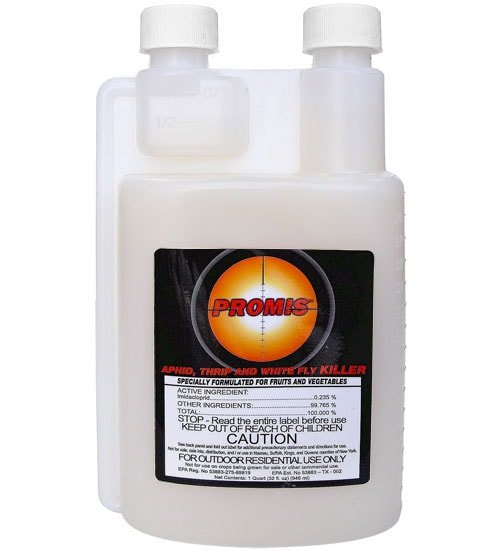Insecticide For Aphids And Thrips
Identifying the Invaders
-
Aphids and thrips are small enough that you may not notice an invasion until their feeding visibly damages your plant’s health. Aphids — tiny, pear-shaped insects of nearly any color — latch onto stems and leaves and drink the plant’s sap through sharp, hollow mouth parts. Most aphids in warm climates give birth to live young, and many of them reproduce year-round. Their classic calling card is honeydew, the sticky leftovers of their feeding. Slender, winged yellowish to black thrips puncture plant tissue and devour its cellular contents, including chlorophyll. Pale stippling or silvering and specks of dark excrement mark their feeding sites. Wind carries thrips from plant to plant.
Bug Them to Death
-
Green lacewing larvae prey on aphids and thrips, and inviting these beneficial bugs to your garden helps keep both pests in check. Each female lacewing lays hundreds of eggs, and each larva consumes up to 600 thrips or aphids a day for two to three weeks before pupating. Adult green lacewings feed on nectar and pollen from flat, shallow-throated flowers. Lure the adults by scattering annual sweet alyssum (Lobularia maritima) and cosmos (Cosmos spp.) around the garden, and let their babies go to work.
Wash Them Away
-
Spraying your outdoor plants with water from the hose dislodges and drowns aphids and thrips. Aim at the leaf undersides where the insects congregate. To remove thrips, set your hose’s spray attachment on fine and spray early in the morning, when the hose water is cold and the lethargic insects aren’t likely to fly away. Getting rid of thrips requires three or more treatments spaced every one or two days. This technique also works with aphid-infested indoor plants, because aphids are stationary. Simply take the plants outside or place them in a sink or shower for spraying.
The Soap Solution
-
Nontoxic, ready-to-use insecticidal soap controls aphids and thrips on garden and indoor plants. It suffocates the bugs it reaches, so direct the spray at the backs of the leaves, the stems, leaf and flower buds and shoot tips where the pests gather. Treat them when no honeybees, lacewings or other beneficials are present, and when no direct sun will hit and possibly damage the plants. To eliminate the pests, you need to spray the plants until they drip and repeat the spraying every two to three days, or at the label’s suggested interval. As a precaution, wear gloves, a long-sleeved shirt, long pants, socks, shoes, protective eyewear and a respiratory mask when spraying. Always apply the soap according to the label’s directions.
Insecticide For Aphids And Thrips
Insecticide for aphids and thrips is a chemical that can be used to kill pests, like aphids and thrips. There are many different insecticides, but when it comes to the two mentioned above, it is more important to know what makes one better than another.
The first thing to consider is the type of insecticide you need. There are two main types: contact and systemic. Contact insecticides kill insects by coming into direct contact with them. Systemic insecticides are absorbed by the insect as they feed on plants treated with the product. Some products can be used in both ways, while others work only one way.
You should also choose a product based on how long you want your plants protected from these pests. Some products will only provide protection for a few days or weeks at a time, while others offer year-round protection against pests like aphids and thrips.
Finally, take note of how much money you want to spend on an insecticide for aphids and thrips. Some products are more expensive than others but offer longer protection from pests such as these two common ones mentioned above!
List Of Insecticide For Aphids And Thrips
- Spotted wing drosophila (SWD) management
- Manage resistance, ideal for insect resistance management (IRM) programs
- O-day pre-harvest interval (PHI), 4-hour re-entry interval (REI), OMRI and NOP listed
- Approved for Organic Use
Additional Info :
- Proven Performance – Ascertain TR contains the same amount of the same active ingredient (Bifenthrin) as the leading brand, providing you with the full protection you need for your valuable greenhouse plants
- Full Coverage – One can of Piston TR treats up to 3,000 square feet. Once activated, the aerosol can releases an ultra-fine mist that circulates through plant foliage to provide optimal coverage against pests
- Target Pests – Effective against mites, aphids, fungus gnats, caterpillars, thrips, whiteflies, armyworms, bagworms, mealybugs, and more garden pests that destroy delicate plants
- Where To Use – Ascertain Total Release Fogger can be used on bedding plants, potted plants, cut flowers, ornamentals, and other non-food crops in commercial greenhouses
- Application Tips – No spray equipment required. Clear out a 3 foot diameter area to prep for application. Make sure all vents and doors to the area being treated are closed. Not for use in and around residential areas.
- Not available for sale in Alaska, Arizona, and North Carolina
Additional Info :
- Venerate CG to control aphids, leafhopper, lygus, stink bug, thrips & more
Additional Info :
| Color | White |
- Spotted wing drosophila (SWD) management
- Manage resistance, ideal for insect resistance management (IRM) programs
- O-day pre-harvest interval (PHI), 4-hour re-entry interval (REI), OMRI and NOP listed
- Approved for Organic Use
Additional Info :
- Fast-Acting Formulation – Kills insects within minutes after contact
- No Visible Residues – Clean formula won’t leave a residue on plant leaves and vegetables
- Kills All Life Stages – For control of foliage feeding worms (caterpillars), aphids, ants, beetles, thrips, mites, & other listed pests
- With Spinosad – Ready to use insecticidal soap formula uses spinosad for added power
- OMRI Listed – Listed with the Organic Mineral Research Institute for organic use
Additional Info :





